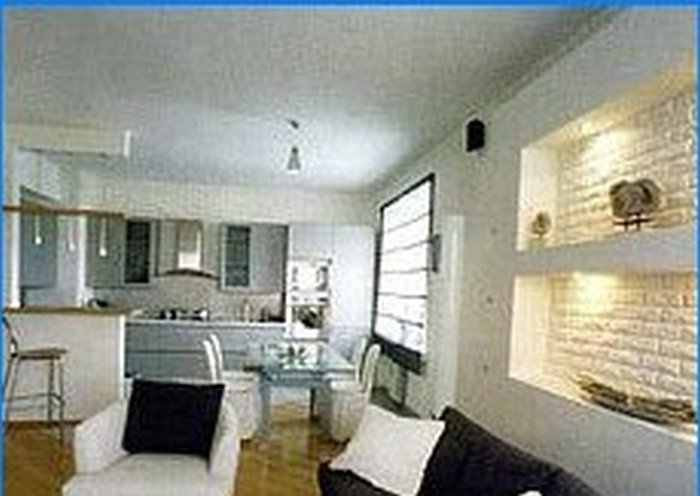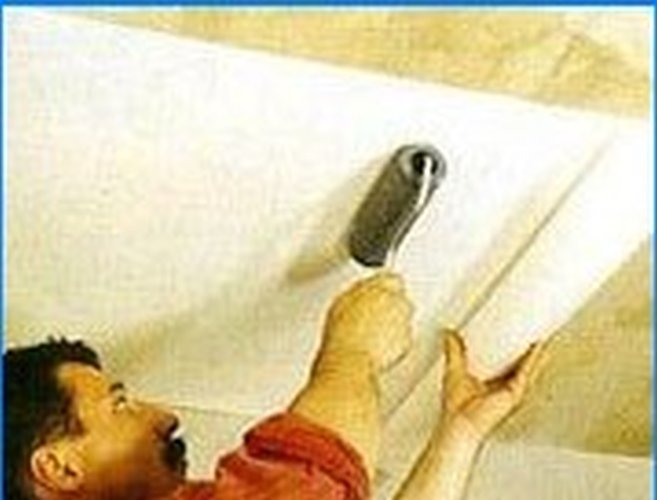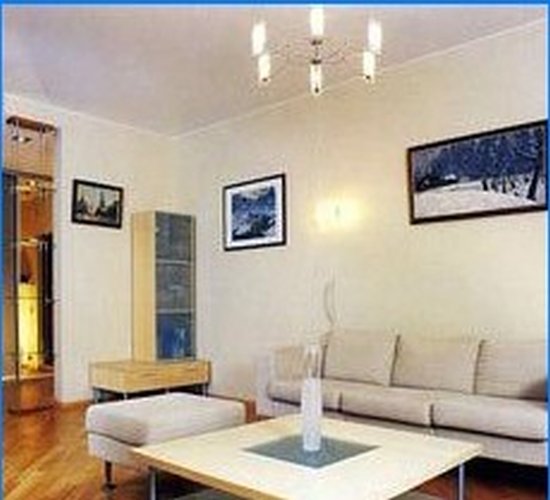Recommendation points
Dear readers, have you ever seen a running ceiling in your life? It is a sad and wonderful sight. First, one gets the impression that they have walked on it – it is so crumpled, pounded and trampled. Secondly, something is constantly falling from him. The impression that the plane overhead has not been renewed since the time of collectivization and the first five-year plans! With such a ceiling, something definitely needs to be done. You can resort to suspended, tension, multi-level, hemming, glue technologies, and cover with special panels. You can even arrange a mirror or star structure. We talked about all these techniques. But for all their prevalence and growing popularity, the most common, “classic” ceilings are still more common in our homes. And it would be completely unfair to ignore traditional repair methods..

We immediately inform our readers: whichever of the methods below you choose, you will not end up with hassle and dirt. The disadvantages are obvious – the process is laborious and messy. In the event of a leak, everything must be changed. But there are also pluses – the ceiling height does not change, the materials are only natural. And, admittedly, not everyone likes the “art” over their heads, many prefer to have a traditional, ordinary smooth ceiling, clean as a sheet of paper.
Removing the old coating
It all starts with removing the old coating. You can use the old proven method: wash out the whitewash with water, and soak the water emulsion with a solution of iodine and clean with a puncher. Now there are special washes, with which you can easily remove any old paint, for example, the washes of the German company “Pufas” or ours, produced in Shchelkovo near Moscow or in Volgograd. The washes are applied to the ceiling with a roller or a wide brush and after 20-30 minutes can be easily removed along with the old paint. Fast and clean!
So, the ceiling was cleared. But before starting work, you need to find out how horizontal you have. The easiest way is to use a plumb line to measure the distance from floor to ceiling in the corners of the room. If it turns out that there is still a slope, you will have to remember this during priming and puttying in order to “return” the ceiling to a horizontal position.

First of all, all seams in the floors are sealed. Indeed, at the junction of the ceiling and wall slabs, “shifts” occur: the house is constantly living, air is blown, wallpaper peels off, plaster and putty are crumbling. For sealing the joints, cement mortar or serpyanka is used, which means just a construction bandage. Serpyanka is glued in strips directly on the rusty (open seams) using PVA glue diluted with water.
The next two stages – primer and putty – are designed to prepare the ceiling for finishing. The primer should saturate the concrete so that nothing falls from the ceiling later, and level the surface. Primers differ in penetration depth – the deeper, the better and more durable. As for the materials, there is plenty to choose from, for example, the products of the same “Pufas”: “Tiffing primer LF” and “Universal Tiffing primer LH”.
Putty is the most important and in some cases quite expensive job. Whether the ceiling is perfectly flat depends on the quality of the putty. The putty itself is a white powder that is diluted with water to obtain a thick, soft mass. There are three types of putty: for indoor, outdoor and wet rooms. The sales leaders are German “Pufas” and Finnish “Vetonit”. Our best putty is from the “Glin” company. Quite tolerable – by the Polish company “Atlas”.
To insure against the appearance of cracks on the ceiling, you can stick ordinary gauze or a wide serpentine directly onto the dry putty, which serve as a reinforcing mesh.
The final touch to obtain a perfectly flat surface is the finishing putty, which hides very small flaws. The finishing putty is fine-grained, that is, completely even and smooth. In a few hours, when the putty dries up, the ceiling is sanded with the most banal sandpaper. Monolithic base, eagerly awaiting painting, ready.
Whitewash
Chalk is diluted with water, blue is added for shade and whitewash is obtained. As a rule, ceilings are whitewashed with special sprayers, less often with a brush. But, as it is believed, a banally whitewashed ceiling is a dubious pleasure, and it does not add to the cleanliness of the house for a long time.
Painting
A more modern way is painting. This is the most time consuming repair method. Only the preparatory process can take one to two weeks. And the painting itself will take 4-5 days, since it is better to paint in 2-3 layers.

The most affordable are conventional water-based and water-based paints, as well as acrylic latex paints. Better – matte. If you look up, as if into a misty distance, the volume visually expands. The difference between water-based and water-dispersion paints from each other is that the first one can be washed off, albeit with difficulty, the second one is absolutely moisture resistant. The advantage of a water dispersion is its durability. “Allows” to wash yourself up to two thousand times! Moreover, this paint is a smoker’s joy. Even if you grind like a locomotive, the ceiling will remain pristine for a very long time..
The best paints are German “Feydal” and “Pufas”, Finnish “Tikkurila”. Quite good domestic ones also appeared – the companies “Raduga” and the Lytkarinsky plant. The range of colors of water emulsion is quite wide. Water-based paint is mostly white only.
If dampness is your problem, it is better to use silicone paints. They form a waterproof film, and in addition, due to their elasticity, they can even “tighten” small cracks. True, such material will cost more than ordinary paint..

If your ceiling is covered with oil paint, there is nothing else you can paint it with. Because the oil is put on a primer with linseed oil, which impregnates the concrete, and no other material will stick to it. In this case, the choice is small: either again oil paint, which turns yellow after two or three years even if all sanitary standards are observed (meaning that you will not constantly smoke and cook food in this room), or – a suspended ceiling. Oil paint – Russian or Belarusian, you can also find Polish. But foreigners justly do not like “butter” and hardly ever supply it. As already mentioned, it prevents the ceiling from breathing and turns yellow quickly..
Unlike whitewashing, you can experiment with colors and types of paint, of which there are now a great many. If you want to paint the ceiling in some exotic color, you cannot do without colorings – coloring additives. By mixing them with the main paint in a certain proportion, you can get any shade. The proportions are always indicated on the container.

Alkyd enamel is also suitable for painting the ceiling. In the West, enamels are used very widely: they are abundantly used in both living quarters and cars. We treat them with caution, for a very banal reason: it is twice as expensive as water-based paints. But on the other hand, the white color of the enamel is whiter than the color of the “white paint”. And the enamel dries faster, and moisture is not afraid of it. On the market – German “Pufas” or Finnish “Vetonit”. The imported enamel has a very wide range of colors, our domestic enamel has a little less. But Turkish is almost always only white.
The packages of all imported materials must contain instructions for use in Russian. Foreigners do not indicate expiration dates – it is believed that paints are durable. Our dates are indicated. But experts assure that a little “expired” paint does not matter, the main thing is to mix it well.
Wallpaper
Wallpaper is also glued to the ceiling. Simple rolls for walls will not work, special wallpapers are needed here – more dense and embossed. If the ceiling has small cracks and irregularities, the wallpaper can hide them..

Russian ceiling wallpapers are only white, but the relief is the most diverse. If you decide to buy imported ones, you can immediately choose the color to taste. However, even colorless wallpaper can be given the desired color scheme. Such material can be painted with water-dispersion paint, and several times. Imported ceiling wallpaper does not need to be impregnated with glue – either the sheet itself or the ceiling is smeared and smoothed with a rubber roller from the middle to the edges. Russian wallpaper must be impregnated with glue for 5-8 minutes.
There are times when ceiling wallpaper is already glued to the ceiling. Be aware: they are glued directly to concrete slabs, which means that you will have to do full preparation for a new coating. But by and large, experts do not recommend gluing paper to the ceiling again – in typical houses, builders do this solely for reasons of speed and cheapness – then they do not have to either prime or putty the ceiling. “Paper beauty” retains the divine appearance for a maximum of three years.

Ideally, the ceiling is updated at the same time as the walls, but we advise you to do all the dirty ceiling work before you start repairing the floor (laying parquet, linoleum, carpet or tiles). But if you still decide to pay attention only to the ceiling, take care of the safety of the floor, walls and furniture. In general, it is not so difficult to bring the ceiling to mind and not for too much money. There would be a desire. The choice of technology and appearance is yours.

I noticed that you mentioned ceiling repair. I’m curious to know what specifically you need help with regarding ceiling repair. Are you looking for tips on how to fix a crack or hole in the ceiling? Or perhaps you need guidance on finding a reliable professional for the job? It would be helpful to have more details so that I can provide you with a more specific answer.